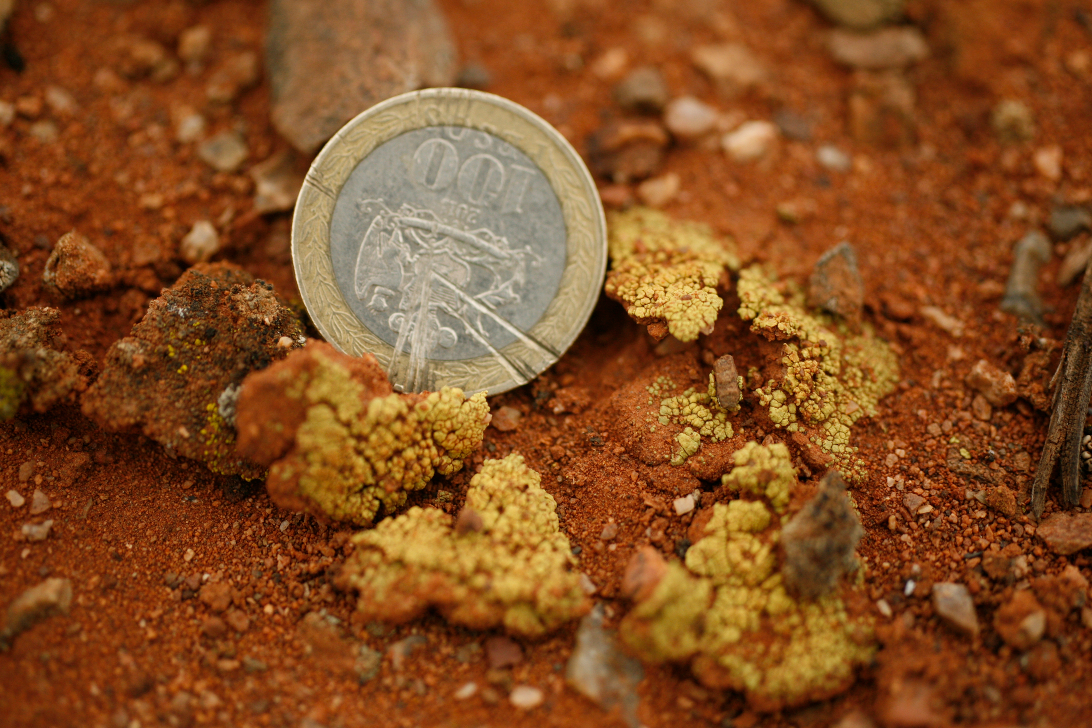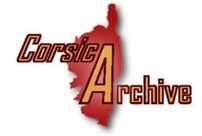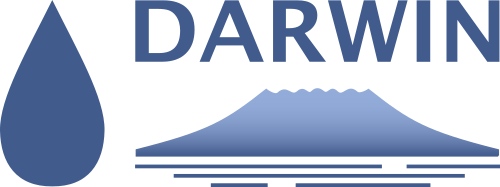Earthshape 1 Structure and function of biocrusts in weathering, soil formation and erosion processes (CRUSTWEATHERING) [funded by DFG] - Status: closed
Project staff:
Prof. Dr. Jörg Bendix
Description:
 On a global scale, biological soil crusts (biocrusts) form the most productive microbial biomass in arid regions. Biocrusts are formed by living organisms such as heterotrophic bacteria, fungi, lichens, bryophytes, cyanobacteria and algae and their by-products, creating a top-soil layer of inorganic particles bound together by organic materials (see image beside). They can be characterized as “ecosystem-engineers” forming water-stable, aggregated surface layers that have important multi-functional ecological roles in primary production, mineralization, bioweathering, dust trapping, and the stabilization of soils, slopes and entire landscapes, thereby affecting the nutrient and hydrological cycles across scales. Intensive literature reviews made us aware that these communities are almost unstudied in South America, although highly abundant in the study areas of the Priority Programme. Therefore, the objectives of this interdisciplinary proposal are to
On a global scale, biological soil crusts (biocrusts) form the most productive microbial biomass in arid regions. Biocrusts are formed by living organisms such as heterotrophic bacteria, fungi, lichens, bryophytes, cyanobacteria and algae and their by-products, creating a top-soil layer of inorganic particles bound together by organic materials (see image beside). They can be characterized as “ecosystem-engineers” forming water-stable, aggregated surface layers that have important multi-functional ecological roles in primary production, mineralization, bioweathering, dust trapping, and the stabilization of soils, slopes and entire landscapes, thereby affecting the nutrient and hydrological cycles across scales. Intensive literature reviews made us aware that these communities are almost unstudied in South America, although highly abundant in the study areas of the Priority Programme. Therefore, the objectives of this interdisciplinary proposal are to
- evaluate the almost unknown community structure of Chilean biocrust types using a combination of field and laboratory methods to address the relative abundance of the full spectrum of biocrust organisms, particularly with regard to their role in weathering and landscape forming processes (who is doing what?);
- disclose which of the abundant organisms contribute by which biochemical processes to bioweathering, and quantify the reaction rates in relation to community structure and environmental conditions;
- uncover the function of biocrusts in the coupled biogeochemical cycling of P- (particular emphasis!), C- and N-compounds across spatial scales from the atomic/molecular-, the single mineral grain-, biocrust patch- and soil profile- up to the slope/catchment-scale, the latter with the help of remotely sensed spectral data and jointly developed transfer functions;
- understand how microclimatic conditions and water availability determine the biocrust community structure and activity, coverage and their functioning in the arid ecosystems.
- Upscaling of 1-4 with remote sensing data to catchments of the PP. The expected results will not only disclose presently unknown biocrust organisms and their physiological and ecological functioning but also enlighten their contribution to bioweathering and fundamental Earth-shaping processes, and provide overall knowledge and data background for regional or global-scale geosystem models.
For further information please visit the official EarthShape page: https://esdynamics.geo.uni-tuebingen.de/earthshape/index.php?id=113

.jpg)

Publications and poster presentations:
2022 - Jung, P.; Lehnert, L.; Bendix, J.; Lentendu, G.; Grube, M.; Alfaro, F.D.; Rio, C.d.; Gutiérrez Alvarado, J.L.; van den Brink, L. & Lakatos, M. (2022): The grit crust: A poly-extremotolerant microbial community from the Atacama Desert as a model for astrobiology. Frontiers in Astronomy and Space Sciences 9, 1052278.
- Baumann, K.; Jung, P.; Lehnert, L.; Samolov, E.; Baum, C.; Bendix, J.; Karsten, U.; Büdel, B. & Leinweber, P. (2022): Die Grüne Wüste Südamerikas? Ökologische Nischen für Pioniere in der Atacama. Biologie in unserer Zeit 52(1), 58--65.
2020 - Jung, P.; Baumann, K.; Lehnert, L.; Samolov, E.; Achilles, S.; Schermer, M.; Wraase, L.M.; Eckhardt, K.; Bader, M.; Leinweber, P.; Karsten, U.; Bendix, J. & Büdel, B. (2020): Desert breath—How fog promotes a novel type of soil biocenosis, forming the coastal Atacama Desert’s living skin. Geobiology n/a(n/a), 1-12.
- Lehnert, L.; Thies, B. & Bendix, J. (2020): A new high spatial resolution low stratus/fog retrieval for the Atacama Desert. Remote Sensing of Environment 236, 111445.
2019 - Jung, P.; Schermer, M.; Briegel-Williams, L.; Baumann, K.; Leinweber, P.; Karsten, U.; Lehnert, L.; Achilles, S.; Bendix, J. & Büdel, B. (2019): Water availability shapes edaphic and lithic cyanobacterial communities in the Atacama Desert1. Journal of Phycology 0(0), 1-22.
- Jung, P.; Emrích, D.; Briegel‐Williams, L.; Schermer, M.; Weber, L.; Baumann, K.; Colesie, C.; Clerc, P.; Lehnert, L.; Achilles, S.; Bendix, J. & Büdel, B. (2019): Ecophysiology and phylogeny of new terricolous and epiphytic chlorolichens in a fog oasis of the Atacama Desert. Microbiology Open 8, 1-21.
2018 - Baumann, K.; Jung, P.; Samolov, E.; Lehnert, L.; Büdel, B.; Karsten, U.; Bendix, J.; Achilles, S.; Schermer, M.; Matus, F.; Oses, R.; Osses, P.; Morshedizad, M.; Oehlschläger, C.; Hu, Y.; Klysubun, W. & Leinweber, P. (2018): Biological soil crusts along a climatic gradient in Chile: Richness and imprints of phototrophic microorganisms in phosphorus biogeochemical cycling. Soil Biology and Biochemistry 127, 286-300.
- Lehnert, L.; Jung, P.; Obermeier, W.; Büdel, B. & Bendix, J. (2018): Estimating Net Photosynthesis of Biological Soil Crusts in the Atacama Using Hyperspectral Remote Sensing. Remote Sensing 10(6), 891.
- Lehnert, L.; Thies, B.; Trachte, K.; Achilles, S.; Osses, P.; Baumann, K.; Schmidt, J.; Samolov, E.; Jung, P.; Leinweber, P.; Büdel, B. & Bendix, J. (2018): A Case Study on Fog/Low Stratus Occurrence at Las Lomitas, Atacama Desert (Chile) as a Water Source for Biological Soil Crusts. Aerosol and Air Quality Research 18(1), 254-269.
2016 - Lehnert, L.; Achilles, S.; Schmidt, J.; Büdel, B.; Osses, P.; Thies, B. & Bendix, J., Fog research in the southern Atacama: Measurement setup and first results of the new EarthShape project(2016).
Datasets:
- AWS raw data from Chile - Santa Gracia station by Lehnert, L.; Achilles, S. & Bendix, J. (2022)
- AWS raw data from Chile - Pan de Azucar - Remote 2 station by Lehnert, L.; Achilles, S. & Bendix, J. (2022)
- AWS raw data from Chile - Pan de Azucar - Remote 1 station by Lehnert, L.; Achilles, S. & Bendix, J. (2022)
- AWS raw data from Chile - Pan de Azucar - Main station by Lehnert, L.; Achilles, S. & Bendix, J. (2022)
- Predicted density and depth of holes created by burrowing animals across 8 hillsides along Chilean climate gradient by Grigusova, P. (2021)




